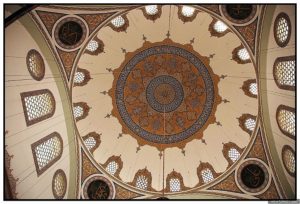Konya Karapınar Ikinci Selim Camii, Mosque of Selim II at Karapınar in Konya, Turkey
 The Sultan Selim Complex demonstrates the concept of imperial and Muslim identity in the Ottoman Empire. Notably, Karapınar means “black spring” in Turkish.[1]
The Sultan Selim Complex demonstrates the concept of imperial and Muslim identity in the Ottoman Empire. Notably, Karapınar means “black spring” in Turkish.[1]
Although many different religious identities existed within the empire, the ruling class was Muslim. As a result, Islam was considered the empire’s prominent religion.[2] The Mosque of Selim II demonstrates the importance of Islam in the Ottoman Empire, as the mosque was both a religious building and part of an imperial complex. Along with the rest of the complex, the mosque upheld several of the Pillars of Islam (mandatory principles of the Faith) such as charity, prayer, and the call to profess one’s faith. For example, the mosque itself is a place of worship and prayer (salat), and the now destroyed imaret (soup kitchen) would have made food for the poor (zakat). Other structures present at this complex included caravanserai (guest lodgings), a bath, and a fountain.[3]
Selim II, the son of Sultan Süleyman, commissioned this complex. As a member of the royal family, his mosque includes two minarets instead of one. Minarets were not only used to call Muslims to prayer, but also symbolized a ruler’s imperial power.[4]

Interestingly, if you look to the ground plan, you may notice the peculiar slicing of the building into four levels. Large central domes were heavy architectural features and needed massive structural support to hold their weight. This “slicing” shows us not levels or stories, but rather the four levels of weight-bearing structures.
By Romina Dellepere, Paris Gedeon, Theo Smith
[1] Allen, Caucasian Battlefields: A History of the Wars on the Turco-Caucasian Border, 1828-1921, 584.
[2] Stanley, Palace and Mosque: Islamic Art from the Middle East, 29.
[3] Kuran, Sinan, The Grand Old Master of Ottoman Architecture, 165.
[4] Kuran, 164.